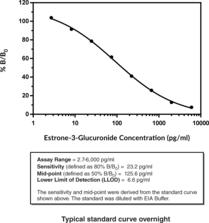Cayman
Showing 20101–20250 of 45550 results
-
Estrone 3-methyl ether is a synthetic estrogen and derivative of estrone (Item No. 10006485).{51105} It stimulates proliferation of estrogen-dependent MCF-7 breast cancer cells in vitro when used at concentrations ranging from 0.16 to 20 μM but lacks estrogen receptor (ER) binding activity (IC50s = >100 μM for ERα and ERβ). Estrone 3-methyl ether has been used in the synthesis of various estrogen receptor modulators.{51106}
Brand:CaymanSKU:27978 - 10 gAvailable on backorder
Estrone 3-methyl ether is a synthetic estrogen and derivative of estrone (Item No. 10006485).{51105} It stimulates proliferation of estrogen-dependent MCF-7 breast cancer cells in vitro when used at concentrations ranging from 0.16 to 20 μM but lacks estrogen receptor (ER) binding activity (IC50s = >100 μM for ERα and ERβ). Estrone 3-methyl ether has been used in the synthesis of various estrogen receptor modulators.{51106}
Brand:CaymanSKU:27978 - 5 gAvailable on backorder
Estrone 3-methyl ether is a synthetic estrogen and derivative of estrone (Item No. 10006485).{51105} It stimulates proliferation of estrogen-dependent MCF-7 breast cancer cells in vitro when used at concentrations ranging from 0.16 to 20 μM but lacks estrogen receptor (ER) binding activity (IC50s = >100 μM for ERα and ERβ). Estrone 3-methyl ether has been used in the synthesis of various estrogen receptor modulators.{51106}
Brand:CaymanSKU:27978 - 500 mgAvailable on backorder
Estrone 3-sulfate is an endogenous steroid and an estrogen ester that is biologically inactive. It is converted by steroid sulfatase into estrone (Item No. 10006485). Estrone 3-sulfate has been investigated as a ligand for targeting organic anion transporting polypeptides for the detection of hormone-dependent breast cancers.{32192}
Brand:CaymanSKU:20513 -Available on backorder
Estrone 3-sulfate is an endogenous steroid and an estrogen ester that is biologically inactive. It is converted by steroid sulfatase into estrone (Item No. 10006485). Estrone 3-sulfate has been investigated as a ligand for targeting organic anion transporting polypeptides for the detection of hormone-dependent breast cancers.{32192}
Brand:CaymanSKU:20513 -Available on backorder
Estrone 3-sulfate is an endogenous steroid and an estrogen ester that is biologically inactive. It is converted by steroid sulfatase into estrone (Item No. 10006485). Estrone 3-sulfate has been investigated as a ligand for targeting organic anion transporting polypeptides for the detection of hormone-dependent breast cancers.{32192}
Brand:CaymanSKU:20513 -Available on backorder
Estrone-3-glucuronide is the predominant metabolite of estradiol in urine and a urinary marker for the fertile window in women.{40240} Measurement of urinary glucuronides is a convenient, non-invasive method for detecting reproductive hormone levels compared to measuring plasma levels.{40241} Estrone-3-glucuronide, along with pregnanediol-3-glucuronide, are indicators of female reproductive health.{40241} Literature has shown high serum estrone levels, which directly correlate to urinary estrone-3-glucuronide levels, are associated with estrogen receptor-positive breast cancers.{40244} Hormone receptor status is the main factor in planning treatment and can be treated with hormone therapies, including tamoxifen and aromatase inhibitors.{40247} In addition to its role in breast cancer, circulating estrogens, including estrone metabolized from oral hormone replacement therapy, have been shown to increase thrombin generation leading to higher risk for blood clots, myocardial infarctions, deep vein thrombosis and strokes.{40245,40246}
Brand:CaymanSKU:501290 - 96 solid plateAvailable on backorder
Estrone-3-glucuronide is the predominant metabolite of estradiol in urine and a urinary marker for the fertile window in women.{40240} Measurement of urinary glucuronides is a convenient, non-invasive method for detecting reproductive hormone levels compared to measuring plasma levels.{40241} Estrone-3-glucuronide, along with pregnanediol-3-glucuronide, are indicators of female reproductive health.{40241} Literature has shown high serum estrone levels, which directly correlate to urinary estrone-3-glucuronide levels, are associated with estrogen receptor-positive breast cancers.{40244} Hormone receptor status is the main factor in planning treatment and can be treated with hormone therapies, including tamoxifen and aromatase inhibitors.{40247} In addition to its role in breast cancer, circulating estrogens, including estrone metabolized from oral hormone replacement therapy, have been shown to increase thrombin generation leading to higher risk for blood clots, myocardial infarctions, deep vein thrombosis and strokes.{40245,40246}
Brand:CaymanSKU:501290 - 96 strip plateAvailable on backorder
Estrone-d2 is intended for use as an internal standard for the quantification of estrone (Item Nos. ISO60165 | 10006485) by GC- or LC-MS. Estrone is one of the three naturally occurring estrogens, the others being estradiol (Item Nos. ISO60155 | 10006315) and estriol (Item Nos. ISO60164 | 10006484).{9611} Estrone is synthesized from androstenedione (Item No. ISO60161) by the aromatase enzyme system in the ovaries and placenta, and is also synthesized from estradiol by 17-hydroxy steroid dehydrogenase in the liver.{9611,8343} Serum concentrations of estrone in premenopausal women fluctuate according to the menstrual cycle and becomes the most predominant estrogen in postmenopausal women.{9611} The binding affinities of estrone to the estrogen receptors α and β are approximately 60% and 37% relative to estradiol.{9611}
Brand:CaymanSKU:9002844 - 1 mgAvailable on backorder
Estrone-d2 is intended for use as an internal standard for the quantification of estrone (Item Nos. ISO60165 | 10006485) by GC- or LC-MS. Estrone is one of the three naturally occurring estrogens, the others being estradiol (Item Nos. ISO60155 | 10006315) and estriol (Item Nos. ISO60164 | 10006484).{9611} Estrone is synthesized from androstenedione (Item No. ISO60161) by the aromatase enzyme system in the ovaries and placenta, and is also synthesized from estradiol by 17-hydroxy steroid dehydrogenase in the liver.{9611,8343} Serum concentrations of estrone in premenopausal women fluctuate according to the menstrual cycle and becomes the most predominant estrogen in postmenopausal women.{9611} The binding affinities of estrone to the estrogen receptors α and β are approximately 60% and 37% relative to estradiol.{9611}
Brand:CaymanSKU:9002844 - 500 µgAvailable on backorder
Estropipate is a piperazine salt form of estrone 3-sulfate (Item No. 20513), which is an inactive endogenous steroid that is converted into estrone (Item No. 10006485) in vivo.{32192} Estropipate is also an inhibitor of organic anion transport polypeptide 1B1 (OATP1B1) that is selective for OAT1B1 over OAT1B3 (IC50s = 0.06 and 19.3 µM, respectively).{41286} Formulations containing estropipate have been used in the treatment of menopausal symptoms and for the prevention of osteoporosis in high risk populations.
Brand:CaymanSKU:23806 - 10 mgAvailable on backorder
Estropipate is a piperazine salt form of estrone 3-sulfate (Item No. 20513), which is an inactive endogenous steroid that is converted into estrone (Item No. 10006485) in vivo.{32192} Estropipate is also an inhibitor of organic anion transport polypeptide 1B1 (OATP1B1) that is selective for OAT1B1 over OAT1B3 (IC50s = 0.06 and 19.3 µM, respectively).{41286} Formulations containing estropipate have been used in the treatment of menopausal symptoms and for the prevention of osteoporosis in high risk populations.
Brand:CaymanSKU:23806 - 5 mgAvailable on backorder
Etaqualone (Item No. 11152) is an analytical reference standard categorized as a quinazolone.{41356} This product is intended for research and forensic applications.
Brand:CaymanSKU:11152 - 1 mgAvailable on backorder
Etaqualone (Item No. 11152) is an analytical reference standard categorized as a quinazolone.{41356} This product is intended for research and forensic applications.
Brand:CaymanSKU:11152 - 10 mgAvailable on backorder
Etaqualone (Item No. 11152) is an analytical reference standard categorized as a quinazolone.{41356} This product is intended for research and forensic applications.
Brand:CaymanSKU:11152 - 5 mgAvailable on backorder
ETC-1002 is a prodrug form of ETC-1002-CoA.{46141} ETC-1002 is conjugated to coenzyme A (CoA) by very long-chain acyl-CoA synthetase-1 (ACSVL1) to form ETC-1002-CoA, which inhibits ATP citrate lyase (Ki = 2 μM) and activates AMP-activated protein kinase (AMPK). ETC-1002 suppresses total lipid synthesis in wild-type and AMPKβ1 knockout primary murine hepatocytes. In vivo, ETC-1002 (30 mg/kg) prevents increases in hepatic cholesterol and reduces the size of aortic atherosclerotic lesions induced by a high-fat high-cholesterol diet in Apoe-/-/Ampkβ1-/- (DKO) mice.
Brand:CaymanSKU:26409 - 10 mgAvailable on backorder
ETC-1002 is a prodrug form of ETC-1002-CoA.{46141} ETC-1002 is conjugated to coenzyme A (CoA) by very long-chain acyl-CoA synthetase-1 (ACSVL1) to form ETC-1002-CoA, which inhibits ATP citrate lyase (Ki = 2 μM) and activates AMP-activated protein kinase (AMPK). ETC-1002 suppresses total lipid synthesis in wild-type and AMPKβ1 knockout primary murine hepatocytes. In vivo, ETC-1002 (30 mg/kg) prevents increases in hepatic cholesterol and reduces the size of aortic atherosclerotic lesions induced by a high-fat high-cholesterol diet in Apoe-/-/Ampkβ1-/- (DKO) mice.
Brand:CaymanSKU:26409 - 25 mgAvailable on backorder
ETC-1002 is a prodrug form of ETC-1002-CoA.{46141} ETC-1002 is conjugated to coenzyme A (CoA) by very long-chain acyl-CoA synthetase-1 (ACSVL1) to form ETC-1002-CoA, which inhibits ATP citrate lyase (Ki = 2 μM) and activates AMP-activated protein kinase (AMPK). ETC-1002 suppresses total lipid synthesis in wild-type and AMPKβ1 knockout primary murine hepatocytes. In vivo, ETC-1002 (30 mg/kg) prevents increases in hepatic cholesterol and reduces the size of aortic atherosclerotic lesions induced by a high-fat high-cholesterol diet in Apoe-/-/Ampkβ1-/- (DKO) mice.
Brand:CaymanSKU:26409 - 5 mgAvailable on backorder
ETC-1002 is a prodrug form of ETC-1002-CoA.{46141} ETC-1002 is conjugated to coenzyme A (CoA) by very long-chain acyl-CoA synthetase-1 (ACSVL1) to form ETC-1002-CoA, which inhibits ATP citrate lyase (Ki = 2 μM) and activates AMP-activated protein kinase (AMPK). ETC-1002 suppresses total lipid synthesis in wild-type and AMPKβ1 knockout primary murine hepatocytes. In vivo, ETC-1002 (30 mg/kg) prevents increases in hepatic cholesterol and reduces the size of aortic atherosclerotic lesions induced by a high-fat high-cholesterol diet in Apoe-/-/Ampkβ1-/- (DKO) mice.
Brand:CaymanSKU:26409 - 50 mgAvailable on backorder
ETC-159 is a potent and orally bioavailable inhibitor of porcupine (PORCN; IC50s = 18.1 and 70 nM for mouse and Xenopus PORCN, respectively).{38876} It inhibits β-catenin reporter activity (IC50 = 2.9 nM) and reduces the interaction of Wnt with its carrier protein WLS via decreased Wnt palmitoleation in STF3A cells, an effect that is reversed by overexpression of recombinant PORCN. ETC-159 inhibits PA-1 teratocarcinoma colony formation in soft agar (IC50 = 35 nM). In vivo, ETC-159 (1-10 mg/kg) reduces tumor growth in a dose-dependent manner in mice carrying a mouse mammary tumor virus LTR-Wnt1 transgene and in A-1 and NCCIT teratocarcinoma mouse xenograft models. It also reduces growth and induces differentiation in colon adenocarcinoma mouse xenograft models that contain R-spondin (RSPO) translocations.
Brand:CaymanSKU:24104 - 1 mgAvailable on backorder
ETC-159 is a potent and orally bioavailable inhibitor of porcupine (PORCN; IC50s = 18.1 and 70 nM for mouse and Xenopus PORCN, respectively).{38876} It inhibits β-catenin reporter activity (IC50 = 2.9 nM) and reduces the interaction of Wnt with its carrier protein WLS via decreased Wnt palmitoleation in STF3A cells, an effect that is reversed by overexpression of recombinant PORCN. ETC-159 inhibits PA-1 teratocarcinoma colony formation in soft agar (IC50 = 35 nM). In vivo, ETC-159 (1-10 mg/kg) reduces tumor growth in a dose-dependent manner in mice carrying a mouse mammary tumor virus LTR-Wnt1 transgene and in A-1 and NCCIT teratocarcinoma mouse xenograft models. It also reduces growth and induces differentiation in colon adenocarcinoma mouse xenograft models that contain R-spondin (RSPO) translocations.
Brand:CaymanSKU:24104 - 10 mgAvailable on backorder
ETC-159 is a potent and orally bioavailable inhibitor of porcupine (PORCN; IC50s = 18.1 and 70 nM for mouse and Xenopus PORCN, respectively).{38876} It inhibits β-catenin reporter activity (IC50 = 2.9 nM) and reduces the interaction of Wnt with its carrier protein WLS via decreased Wnt palmitoleation in STF3A cells, an effect that is reversed by overexpression of recombinant PORCN. ETC-159 inhibits PA-1 teratocarcinoma colony formation in soft agar (IC50 = 35 nM). In vivo, ETC-159 (1-10 mg/kg) reduces tumor growth in a dose-dependent manner in mice carrying a mouse mammary tumor virus LTR-Wnt1 transgene and in A-1 and NCCIT teratocarcinoma mouse xenograft models. It also reduces growth and induces differentiation in colon adenocarcinoma mouse xenograft models that contain R-spondin (RSPO) translocations.
Brand:CaymanSKU:24104 - 25 mgAvailable on backorder
ETC-159 is a potent and orally bioavailable inhibitor of porcupine (PORCN; IC50s = 18.1 and 70 nM for mouse and Xenopus PORCN, respectively).{38876} It inhibits β-catenin reporter activity (IC50 = 2.9 nM) and reduces the interaction of Wnt with its carrier protein WLS via decreased Wnt palmitoleation in STF3A cells, an effect that is reversed by overexpression of recombinant PORCN. ETC-159 inhibits PA-1 teratocarcinoma colony formation in soft agar (IC50 = 35 nM). In vivo, ETC-159 (1-10 mg/kg) reduces tumor growth in a dose-dependent manner in mice carrying a mouse mammary tumor virus LTR-Wnt1 transgene and in A-1 and NCCIT teratocarcinoma mouse xenograft models. It also reduces growth and induces differentiation in colon adenocarcinoma mouse xenograft models that contain R-spondin (RSPO) translocations.
Brand:CaymanSKU:24104 - 5 mgAvailable on backorder
Etelcalcetide is a peptide agonist of the calcium-sensing receptor (CaSR).{47345} It is selective for CaSR over a panel of 33 receptors and ion channels, as well as the norepinephrine transporter at 10 µM. Etelcalcetide increases intracellular calcium levels in HEK293T cells expressing the human CaSR receptor with an EC50 value of 0.53 µM. It also inhibits parathyroid secretion from primary rat parathyroid cells (EC50 = 0.36 µM in the presence of calcium). Etelcalcetide (0.3, 1, and 3 mg/kg) decreases parathyroid hormone and calcium levels in plasma and serum, respectively, in a model of chronic renal insufficiency with secondary hyperthyroidism in nephrectomized rats fed a high-phosphorus diet. Formulations containing etelcalcetide have been used in the treatment of secondary hyperparathyroidism in adult patients with chronic kidney disease undergoing hemodialysis.
Brand:CaymanSKU:26901 - 1 mgAvailable on backorder
Etelcalcetide is a peptide agonist of the calcium-sensing receptor (CaSR).{47345} It is selective for CaSR over a panel of 33 receptors and ion channels, as well as the norepinephrine transporter at 10 µM. Etelcalcetide increases intracellular calcium levels in HEK293T cells expressing the human CaSR receptor with an EC50 value of 0.53 µM. It also inhibits parathyroid secretion from primary rat parathyroid cells (EC50 = 0.36 µM in the presence of calcium). Etelcalcetide (0.3, 1, and 3 mg/kg) decreases parathyroid hormone and calcium levels in plasma and serum, respectively, in a model of chronic renal insufficiency with secondary hyperthyroidism in nephrectomized rats fed a high-phosphorus diet. Formulations containing etelcalcetide have been used in the treatment of secondary hyperparathyroidism in adult patients with chronic kidney disease undergoing hemodialysis.
Brand:CaymanSKU:26901 - 10 mgAvailable on backorder
Etelcalcetide is a peptide agonist of the calcium-sensing receptor (CaSR).{47345} It is selective for CaSR over a panel of 33 receptors and ion channels, as well as the norepinephrine transporter at 10 µM. Etelcalcetide increases intracellular calcium levels in HEK293T cells expressing the human CaSR receptor with an EC50 value of 0.53 µM. It also inhibits parathyroid secretion from primary rat parathyroid cells (EC50 = 0.36 µM in the presence of calcium). Etelcalcetide (0.3, 1, and 3 mg/kg) decreases parathyroid hormone and calcium levels in plasma and serum, respectively, in a model of chronic renal insufficiency with secondary hyperthyroidism in nephrectomized rats fed a high-phosphorus diet. Formulations containing etelcalcetide have been used in the treatment of secondary hyperparathyroidism in adult patients with chronic kidney disease undergoing hemodialysis.
Brand:CaymanSKU:26901 - 5 mgAvailable on backorder
Ethacrynic acid is a loop diuretic with anticancer activity.{53194},{33064,33063} It inhibits the Na-K-2Cl (NKCC) cotransporter in duck erythrocytes (IC50 = 0.18 mM) and ATP-dependent chloride uptake in rat renal plasma membrane vesicles when used at a concentration of 0.3 mM.{53194},{33062} Ethacrynic acid also inhibits glutathione S-transferase P1-1 (GSTP1-1) and GSTA3-3 (IC50s = 4.9 and ~0.4 μM, respectively), and inhibits Wnt/β-catenin signaling in a cell-based reporter assay.{41510,33064} It is cytotoxic to primary chronic lymphocytic leukemia cells (IC50 = 8.56 μM), as well as MCF-7, MDA-MB-231, and 4T1 cancer cells (IC50s = 45.53, 39.64, and 25.23 μM, respectively).{33064,33063} Ethacrynic acid (250 μg per day) increases tumor growth reduction induced by the EGFR family inhibitors afatinib (Item Nos. 11492 | 21567) or neratinib (Item No. 18404) in a 4T1 murine breast cancer model.{33063} Formulations containing ethacrynic acid have been used in the treatment of edema.
Brand:CaymanSKU:-Available on backorder
Ethacrynic acid is a loop diuretic with anticancer activity.{53194},{33064,33063} It inhibits the Na-K-2Cl (NKCC) cotransporter in duck erythrocytes (IC50 = 0.18 mM) and ATP-dependent chloride uptake in rat renal plasma membrane vesicles when used at a concentration of 0.3 mM.{53194},{33062} Ethacrynic acid also inhibits glutathione S-transferase P1-1 (GSTP1-1) and GSTA3-3 (IC50s = 4.9 and ~0.4 μM, respectively), and inhibits Wnt/β-catenin signaling in a cell-based reporter assay.{41510,33064} It is cytotoxic to primary chronic lymphocytic leukemia cells (IC50 = 8.56 μM), as well as MCF-7, MDA-MB-231, and 4T1 cancer cells (IC50s = 45.53, 39.64, and 25.23 μM, respectively).{33064,33063} Ethacrynic acid (250 μg per day) increases tumor growth reduction induced by the EGFR family inhibitors afatinib (Item Nos. 11492 | 21567) or neratinib (Item No. 18404) in a 4T1 murine breast cancer model.{33063} Formulations containing ethacrynic acid have been used in the treatment of edema.
Brand:CaymanSKU:-Available on backorder
Ethacrynic acid (Item No. 26299) is an analytical reference standard categorized as a loop diuretic.{33062} Diuretics, including ethacrynic acid, have been used as masking agents in sports doping, including racehorse doping.{48475,46368} This product is intended for use in analytical forensic applications. This product is also available as a general research tool (Item No. 19536).
Brand:CaymanSKU:26299 - 10 mgAvailable on backorder
Ethacrynic acid is a loop diuretic with anticancer activity.{53194},{33064,33063} It inhibits the Na-K-2Cl (NKCC) cotransporter in duck erythrocytes (IC50 = 0.18 mM) and ATP-dependent chloride uptake in rat renal plasma membrane vesicles when used at a concentration of 0.3 mM.{53194},{33062} Ethacrynic acid also inhibits glutathione S-transferase P1-1 (GSTP1-1) and GSTA3-3 (IC50s = 4.9 and ~0.4 μM, respectively), and inhibits Wnt/β-catenin signaling in a cell-based reporter assay.{41510,33064} It is cytotoxic to primary chronic lymphocytic leukemia cells (IC50 = 8.56 μM), as well as MCF-7, MDA-MB-231, and 4T1 cancer cells (IC50s = 45.53, 39.64, and 25.23 μM, respectively).{33064,33063} Ethacrynic acid (250 μg per day) increases tumor growth reduction induced by the EGFR family inhibitors afatinib (Item Nos. 11492 | 21567) or neratinib (Item No. 18404) in a 4T1 murine breast cancer model.{33063} Formulations containing ethacrynic acid have been used in the treatment of edema.
Brand:CaymanSKU:-Available on backorder
Ethacrynic acid (Item No. 26299) is an analytical reference standard categorized as a loop diuretic.{33062} Diuretics, including ethacrynic acid, have been used as masking agents in sports doping, including racehorse doping.{48475,46368} This product is intended for use in analytical forensic applications. This product is also available as a general research tool (Item No. 19536).
Brand:CaymanSKU:26299 - 50 mgAvailable on backorder
Ethacrynic acid-d5 is intended for use as an internal standard for the quantification of ethacrynic acid (Item No. 19536) by GC- or LC-MS. Ethacrynic acid is a loop diuretic with anticancer activity.{53194,33064,33063} It inhibits the Na-K-2Cl (NKCC) cotransporter in duck erythrocytes (IC50 = 0.18 mM) and ATP-dependent chloride uptake in rat renal plasma membrane vesicles when used at a concentration of 0.3 mM.{53194,33062} Ethacrynic acid also inhibits glutathione S-transferase P1-1 (GSTP1-1) and GSTA3-3 (IC50s = 4.9 and ~0.4 μM, respectively), and inhibits Wnt/β-catenin signaling in a cell-based reporter assay.{33064,41510} It is cytotoxic to primary chronic lymphocytic leukemia cells (IC50 = 8.56 μM), as well as MCF-7, MDA-MB-231, and 4T1 cancer cells (IC50s = 45.53, 39.64, and 25.23 μM, respectively).{33064,33063} Ethacrynic acid (250 μg per day) increases tumor growth reduction induced by the EGFR family inhibitors afatinib (Item Nos. 11492 | 21567 ) or neratinib (Item No. 18404) in a 4T1 murine breast cancer model.{33063} Formulations containing ethacrynic acid have been used in the treatment of edema.
Brand:CaymanSKU:28537 - 2 mgAvailable on backorder
Ethambutol is an antimycobacterial compound that inhibits the growth of M. tuberculosis in vitro at a concentration of 10 μg/ml.{40409} It is protective against M. smegmatis infections in rhesus monkeys (50, 30, and 0% fatalities at doses of 12.5, 25, and 50 mg/kg, respectively) and clears M. smegmatis pulmonary infiltrates at a dose of 100 mg/kg.{40410} Formulations containing ethambutol have been used in the treatment of tuberculosis.
Brand:CaymanSKU:23713 - 1 gAvailable on backorder
Ethambutol is an antimycobacterial compound that inhibits the growth of M. tuberculosis in vitro at a concentration of 10 μg/ml.{40409} It is protective against M. smegmatis infections in rhesus monkeys (50, 30, and 0% fatalities at doses of 12.5, 25, and 50 mg/kg, respectively) and clears M. smegmatis pulmonary infiltrates at a dose of 100 mg/kg.{40410} Formulations containing ethambutol have been used in the treatment of tuberculosis.
Brand:CaymanSKU:23713 - 10 gAvailable on backorder
Ethambutol is an antimycobacterial compound that inhibits the growth of M. tuberculosis in vitro at a concentration of 10 μg/ml.{40409} It is protective against M. smegmatis infections in rhesus monkeys (50, 30, and 0% fatalities at doses of 12.5, 25, and 50 mg/kg, respectively) and clears M. smegmatis pulmonary infiltrates at a dose of 100 mg/kg.{40410} Formulations containing ethambutol have been used in the treatment of tuberculosis.
Brand:CaymanSKU:23713 - 5 gAvailable on backorder
Ethamivan is a phenol that has been found in M. esculenta and has antioxidant and analeptic properties.{53792,53793,53794} It scavenges 2,2-diphenyl-1-picrylhydrazyl (DPPH; Item No. 14805) and ABTS (Item No. 27317) radicals with EC50 values of 0.374 and 0.05 mg/ml, respectively, in cell-free assays.{53792} Ethamivan (0.25 mg/kg, i.v.) increases the respiratory rate of anesthetized cats, an effect that can be blocked by cervical vagotomy.{53793} Intravenous infusion of ethamivan (19.4-25.2 mg/kg) induces convulsions in conscious cats.{53794}
Brand:CaymanSKU:30876 - 1 gAvailable on backorder
Ethamivan is a phenol that has been found in M. esculenta and has antioxidant and analeptic properties.{53792,53793,53794} It scavenges 2,2-diphenyl-1-picrylhydrazyl (DPPH; Item No. 14805) and ABTS (Item No. 27317) radicals with EC50 values of 0.374 and 0.05 mg/ml, respectively, in cell-free assays.{53792} Ethamivan (0.25 mg/kg, i.v.) increases the respiratory rate of anesthetized cats, an effect that can be blocked by cervical vagotomy.{53793} Intravenous infusion of ethamivan (19.4-25.2 mg/kg) induces convulsions in conscious cats.{53794}
Brand:CaymanSKU:30876 - 250 mgAvailable on backorder
Ethamivan is a phenol that has been found in M. esculenta and has antioxidant and analeptic properties.{53792,53793,53794} It scavenges 2,2-diphenyl-1-picrylhydrazyl (DPPH; Item No. 14805) and ABTS (Item No. 27317) radicals with EC50 values of 0.374 and 0.05 mg/ml, respectively, in cell-free assays.{53792} Ethamivan (0.25 mg/kg, i.v.) increases the respiratory rate of anesthetized cats, an effect that can be blocked by cervical vagotomy.{53793} Intravenous infusion of ethamivan (19.4-25.2 mg/kg) induces convulsions in conscious cats.{53794}
Brand:CaymanSKU:30876 - 500 mgAvailable on backorder
Brand:CaymanSKU:700566 - 2 mlAvailable on backorder
Etherolenic acid is a divinyl ether oxylipin.{1809,57108} It is a metabolite of linolenic acid that is formed in plants via 13-lipoxygenase-mediated formation of 13(S)-HpOTrE (Item No. 45220) followed by conversion to the divinyl ether by divinyl ether synthase.
Brand:CaymanSKU:10005123 - 150 µgAvailable on backorder
Etherolenic acid is a divinyl ether oxylipin.{1809,57108} It is a metabolite of linolenic acid that is formed in plants via 13-lipoxygenase-mediated formation of 13(S)-HpOTrE (Item No. 45220) followed by conversion to the divinyl ether by divinyl ether synthase.
Brand:CaymanSKU:-Ethionamide is an antimycobacterial compound that is active against M. tuberculosis (MICs = 0.3-1.25 µg/ml).{41216,41215} It is activated via oxidation by flavin monooxygenase and inhibits the InhA enzyme involved in mycolic acid biosynthesis.{41216} Formulations containing ethionamide have been used in the second-line treatment of multi-drug resistant tuberculosis.
Brand:CaymanSKU:23714 - 1 gAvailable on backorder
Ethionamide is an antimycobacterial compound that is active against M. tuberculosis (MICs = 0.3-1.25 µg/ml).{41216,41215} It is activated via oxidation by flavin monooxygenase and inhibits the InhA enzyme involved in mycolic acid biosynthesis.{41216} Formulations containing ethionamide have been used in the second-line treatment of multi-drug resistant tuberculosis.
Brand:CaymanSKU:23714 - 10 gAvailable on backorder
Ethionamide is an antimycobacterial compound that is active against M. tuberculosis (MICs = 0.3-1.25 µg/ml).{41216,41215} It is activated via oxidation by flavin monooxygenase and inhibits the InhA enzyme involved in mycolic acid biosynthesis.{41216} Formulations containing ethionamide have been used in the second-line treatment of multi-drug resistant tuberculosis.
Brand:CaymanSKU:23714 - 5 gAvailable on backorder
Ethisterone is an orally bioavailable synthetic progestin and a derivative of testosterone (Item Nos. ISO60154 | 15645) that binds to progesterone and androgen receptors (EC50s = 23 and 23.1 nM, respectively, in yeast).{40099} Ethisterone (1 µM) downregulates progesterone receptors in MCF-7 cells.{40098}
Brand:CaymanSKU:22893 - 1 gAvailable on backorder
Ethisterone is an orally bioavailable synthetic progestin and a derivative of testosterone (Item Nos. ISO60154 | 15645) that binds to progesterone and androgen receptors (EC50s = 23 and 23.1 nM, respectively, in yeast).{40099} Ethisterone (1 µM) downregulates progesterone receptors in MCF-7 cells.{40098}
Brand:CaymanSKU:22893 - 10 gAvailable on backorder
Ethisterone is an orally bioavailable synthetic progestin and a derivative of testosterone (Item Nos. ISO60154 | 15645) that binds to progesterone and androgen receptors (EC50s = 23 and 23.1 nM, respectively, in yeast).{40099} Ethisterone (1 µM) downregulates progesterone receptors in MCF-7 cells.{40098}
Brand:CaymanSKU:22893 - 25 gAvailable on backorder
Ethisterone is an orally bioavailable synthetic progestin and a derivative of testosterone (Item Nos. ISO60154 | 15645) that binds to progesterone and androgen receptors (EC50s = 23 and 23.1 nM, respectively, in yeast).{40099} Ethisterone (1 µM) downregulates progesterone receptors in MCF-7 cells.{40098}
Brand:CaymanSKU:22893 - 5 gAvailable on backorder
Ethoprop is an organothiophosphate nematicide and insecticide.{48845,48846,48847} It decreases the infectivity of M. chitwoodi and M. hapla second-stage juveniles (EC50s = 5.6 and 6.8 μg/ml, respectively) and inhibits hatching of M. chitwoodi egg masses and M. chitwoodi and M. hapla free eggs (EC50s = 0.2, 46, and 83.3 μg/ml, respectively).{48846} Ethoprop (1.8 μg/g) decreases the number of M. chitwoodi nematodes in tomato roots when added to soil from fields without previous ethoprop exposure, but is biodegraded in soil from fields previously exposed to ethoprop. In field trials, it decreases the percentage of potato tubers damaged by wireworms when applied as granules in the planting furrow at a concentration of 3 kg AI/ha.{48847} Ethoprop is toxic to rats via oral administration and dermal contact (LD50s = 47 and 226 mg/kg, respectively) as well as inhalation (LD50 = 0.123 mg/L).{48845} It is also toxic to bluegill (LC50 = 0.32 mg/L). Formulations containing ethoprop have been used in the agricultural control of pests.
Brand:CaymanSKU:27609 - 100 mgAvailable on backorder
Ethoprop is an organothiophosphate nematicide and insecticide.{48845,48846,48847} It decreases the infectivity of M. chitwoodi and M. hapla second-stage juveniles (EC50s = 5.6 and 6.8 μg/ml, respectively) and inhibits hatching of M. chitwoodi egg masses and M. chitwoodi and M. hapla free eggs (EC50s = 0.2, 46, and 83.3 μg/ml, respectively).{48846} Ethoprop (1.8 μg/g) decreases the number of M. chitwoodi nematodes in tomato roots when added to soil from fields without previous ethoprop exposure, but is biodegraded in soil from fields previously exposed to ethoprop. In field trials, it decreases the percentage of potato tubers damaged by wireworms when applied as granules in the planting furrow at a concentration of 3 kg AI/ha.{48847} Ethoprop is toxic to rats via oral administration and dermal contact (LD50s = 47 and 226 mg/kg, respectively) as well as inhalation (LD50 = 0.123 mg/L).{48845} It is also toxic to bluegill (LC50 = 0.32 mg/L). Formulations containing ethoprop have been used in the agricultural control of pests.
Brand:CaymanSKU:27609 - 50 mgAvailable on backorder
Ethopropazine is a butyrylcholinesterase (BChE) inhibitor (IC50 = 15.14 µM in human erythrocyte lysates).{53481} It is selective for BChE over acetylcholinesterase (AChE) at 500 µM. Ethopropazine also binds to rat forebrain and hindbrain membrane preparations (Kis = 3.1 and 7.2 nM, respectively), which are endogenously enriched in M1 and M2 muscarinic acetylcholine receptors, respectively.{53482} Ethopropazine (0.232 mg/kg) decreases the intensity and increases the latency of haloperidol-induced catalepsy, a model of extrapyramidal syndrome, in rats when used in combination with the adenosine A2A receptor antagonist ZM 241395 (Item No. 20447).{53483} It reduces thermal hyperalgesia in a rat model of neuropathic pain induced by sciatic nerve ligation when administered at doses of 20 and 30 mg/kg.{53484} Formulations containing ethopropazine were previously used in the treatment of Parkinson’s disease.
Brand:CaymanSKU:28493 - 10 mgAvailable on backorder
Ethopropazine is a butyrylcholinesterase (BChE) inhibitor (IC50 = 15.14 µM in human erythrocyte lysates).{53481} It is selective for BChE over acetylcholinesterase (AChE) at 500 µM. Ethopropazine also binds to rat forebrain and hindbrain membrane preparations (Kis = 3.1 and 7.2 nM, respectively), which are endogenously enriched in M1 and M2 muscarinic acetylcholine receptors, respectively.{53482} Ethopropazine (0.232 mg/kg) decreases the intensity and increases the latency of haloperidol-induced catalepsy, a model of extrapyramidal syndrome, in rats when used in combination with the adenosine A2A receptor antagonist ZM 241395 (Item No. 20447).{53483} It reduces thermal hyperalgesia in a rat model of neuropathic pain induced by sciatic nerve ligation when administered at doses of 20 and 30 mg/kg.{53484} Formulations containing ethopropazine were previously used in the treatment of Parkinson’s disease.
Brand:CaymanSKU:28493 - 100 mgAvailable on backorder
Ethopropazine is a butyrylcholinesterase (BChE) inhibitor (IC50 = 15.14 µM in human erythrocyte lysates).{53481} It is selective for BChE over acetylcholinesterase (AChE) at 500 µM. Ethopropazine also binds to rat forebrain and hindbrain membrane preparations (Kis = 3.1 and 7.2 nM, respectively), which are endogenously enriched in M1 and M2 muscarinic acetylcholine receptors, respectively.{53482} Ethopropazine (0.232 mg/kg) decreases the intensity and increases the latency of haloperidol-induced catalepsy, a model of extrapyramidal syndrome, in rats when used in combination with the adenosine A2A receptor antagonist ZM 241395 (Item No. 20447).{53483} It reduces thermal hyperalgesia in a rat model of neuropathic pain induced by sciatic nerve ligation when administered at doses of 20 and 30 mg/kg.{53484} Formulations containing ethopropazine were previously used in the treatment of Parkinson’s disease.
Brand:CaymanSKU:28493 - 25 mgAvailable on backorder
Ethopropazine is a butyrylcholinesterase (BChE) inhibitor (IC50 = 15.14 µM in human erythrocyte lysates).{53481} It is selective for BChE over acetylcholinesterase (AChE) at 500 µM. Ethopropazine also binds to rat forebrain and hindbrain membrane preparations (Kis = 3.1 and 7.2 nM, respectively), which are endogenously enriched in M1 and M2 muscarinic acetylcholine receptors, respectively.{53482} Ethopropazine (0.232 mg/kg) decreases the intensity and increases the latency of haloperidol-induced catalepsy, a model of extrapyramidal syndrome, in rats when used in combination with the adenosine A2A receptor antagonist ZM 241395 (Item No. 20447).{53483} It reduces thermal hyperalgesia in a rat model of neuropathic pain induced by sciatic nerve ligation when administered at doses of 20 and 30 mg/kg.{53484} Formulations containing ethopropazine were previously used in the treatment of Parkinson’s disease.
Brand:CaymanSKU:28493 - 50 mgAvailable on backorder
Ethosuximide is an anticonvulsant.{36303,36304,36305,36306,36307} It increases glucose, fructose-1,6-bisphosphate, and pyruvate levels in rat brain when administered at a dose of 200 mg/kg.{36303} Ethosuximide (400 mg/kg) reduces the severity of audiogenic seizures in a rat model of barbiturate withdrawal-induced convulsions.{36304} It also inhibits tonic hindlimb extension induced by pentylenetetrazole (PTZ; Item No. 18682) or brainstem stimulation (ED50s = 35 and 70 mg/kg, respectively), as well as leptazol-induced clonic seizures (ED50 = 230 mg/kg), in rats.{36305,36306} Ethosuximide reduces resting tremor by 60% in a macaque model of Parkinson’s disease induced by MPTP when administered at a dose of 150 mg/animal for 5 days.{36307} Formulations containing ethosuximide have been used in the treatment of petit mal seizures.
Brand:CaymanSKU:23947 - 1 gAvailable on backorder
Ethosuximide is an anticonvulsant.{36303,36304,36305,36306,36307} It increases glucose, fructose-1,6-bisphosphate, and pyruvate levels in rat brain when administered at a dose of 200 mg/kg.{36303} Ethosuximide (400 mg/kg) reduces the severity of audiogenic seizures in a rat model of barbiturate withdrawal-induced convulsions.{36304} It also inhibits tonic hindlimb extension induced by pentylenetetrazole (PTZ; Item No. 18682) or brainstem stimulation (ED50s = 35 and 70 mg/kg, respectively), as well as leptazol-induced clonic seizures (ED50 = 230 mg/kg), in rats.{36305,36306} Ethosuximide reduces resting tremor by 60% in a macaque model of Parkinson’s disease induced by MPTP when administered at a dose of 150 mg/animal for 5 days.{36307} Formulations containing ethosuximide have been used in the treatment of petit mal seizures.
Brand:CaymanSKU:23947 - 500 mgAvailable on backorder
Ethosuximide-d5 is intended for use as an internal standard for the quantification of ethosuximide (Item No. 23947) by GC- or LC-MS. Ethosuximide is an anticonvulsant.{36303,36304,36305,36306,36307} It increases glucose, fructose-1,6-bisphosphate, and pyruvate levels in rat brain when administered at a dose of 200 mg/kg.{36303} Ethosuximide (400 mg/kg) reduces the severity of audiogenic seizures in a rat model of barbiturate withdrawal-induced convulsions.{36304} It also inhibits tonic hindlimb extension induced by pentylenetetrazole (PTZ; Item No. 18682) or brainstem stimulation (ED50s = 35 and 70 mg/kg, respectively), as well as leptazol-induced clonic seizures (ED50 = 230 mg/kg), in rats.{36305,36306} Ethosuximide reduces resting tremor by 60% in a macaque model of Parkinson’s disease induced by MPTP when administered at a dose of 150 mg/animal for 5 days.{36307} Formulations containing ethosuximide have been used in the treatment of petit mal seizures.
Brand:CaymanSKU:30759 - 1 mgAvailable on backorder
Ethosuximide-d5 is intended for use as an internal standard for the quantification of ethosuximide (Item No. 23947) by GC- or LC-MS. Ethosuximide is an anticonvulsant.{36303,36304,36305,36306,36307} It increases glucose, fructose-1,6-bisphosphate, and pyruvate levels in rat brain when administered at a dose of 200 mg/kg.{36303} Ethosuximide (400 mg/kg) reduces the severity of audiogenic seizures in a rat model of barbiturate withdrawal-induced convulsions.{36304} It also inhibits tonic hindlimb extension induced by pentylenetetrazole (PTZ; Item No. 18682) or brainstem stimulation (ED50s = 35 and 70 mg/kg, respectively), as well as leptazol-induced clonic seizures (ED50 = 230 mg/kg), in rats.{36305,36306} Ethosuximide reduces resting tremor by 60% in a macaque model of Parkinson’s disease induced by MPTP when administered at a dose of 150 mg/animal for 5 days.{36307} Formulations containing ethosuximide have been used in the treatment of petit mal seizures.
Brand:CaymanSKU:30759 - 5 mgAvailable on backorder
Ethotoin is a hydantoin anticonvulsant.{37306,37305} It shortens the duration of the tonic extensor aspect of seizures induced by maximal electroshock in rats when administered at doses ranging from 500-1,000 mg/kg.{37305} It also decreases the duration of the tonic phase of seizures at a dose of 1,000 mg/kg but does not affect the duration of the clonic phase at any dose.{37305} Ethotoin (20 mg/kg, i.p.) decreases serum cholesterol and triglyceride concentrations in mice to 67 and 60%, respectively, of control after 16 days of treatment.{37307} Formulations containing ethotoin have been used in the treatment of tonic-clonic and complex partial seizures.
Brand:CaymanSKU:24022 - 10 mgAvailable on backorder
Ethotoin is a hydantoin anticonvulsant.{37306,37305} It shortens the duration of the tonic extensor aspect of seizures induced by maximal electroshock in rats when administered at doses ranging from 500-1,000 mg/kg.{37305} It also decreases the duration of the tonic phase of seizures at a dose of 1,000 mg/kg but does not affect the duration of the clonic phase at any dose.{37305} Ethotoin (20 mg/kg, i.p.) decreases serum cholesterol and triglyceride concentrations in mice to 67 and 60%, respectively, of control after 16 days of treatment.{37307} Formulations containing ethotoin have been used in the treatment of tonic-clonic and complex partial seizures.
Brand:CaymanSKU:24022 - 25 mgAvailable on backorder
Ethotoin is a hydantoin anticonvulsant.{37306,37305} It shortens the duration of the tonic extensor aspect of seizures induced by maximal electroshock in rats when administered at doses ranging from 500-1,000 mg/kg.{37305} It also decreases the duration of the tonic phase of seizures at a dose of 1,000 mg/kg but does not affect the duration of the clonic phase at any dose.{37305} Ethotoin (20 mg/kg, i.p.) decreases serum cholesterol and triglyceride concentrations in mice to 67 and 60%, respectively, of control after 16 days of treatment.{37307} Formulations containing ethotoin have been used in the treatment of tonic-clonic and complex partial seizures.
Brand:CaymanSKU:24022 - 5 mgAvailable on backorder
Ethoxyquin is an antioxidant that is widely used in animal feed to protect against lipid peroxidation and fat rancidity in chicken, salmon, and beef.{36124} In vitro, ethoxyquin protects human lymphocytes against hydrogen peroxide-induced DNA damage and reduces micronuclei formation.{36125} In vivo, it reduces the number of chromosome aberrations, micronuclei, and dominant lethal mutations induced by cyclophosphamide (Item No. 13849) in mice, rats, and Chinese hamsters.{36126,36127} Ethoxyquin also induces chromosome aberrations such as atypical translocations, breaks, and dicentrics in human lymphocytes and CHO cells as well as in vivo kidney and bladder damage in rats.{36124}
Brand:CaymanSKU:23094 - 10 gAvailable on backorder
Ethoxyquin is an antioxidant that is widely used in animal feed to protect against lipid peroxidation and fat rancidity in chicken, salmon, and beef.{36124} In vitro, ethoxyquin protects human lymphocytes against hydrogen peroxide-induced DNA damage and reduces micronuclei formation.{36125} In vivo, it reduces the number of chromosome aberrations, micronuclei, and dominant lethal mutations induced by cyclophosphamide (Item No. 13849) in mice, rats, and Chinese hamsters.{36126,36127} Ethoxyquin also induces chromosome aberrations such as atypical translocations, breaks, and dicentrics in human lymphocytes and CHO cells as well as in vivo kidney and bladder damage in rats.{36124}
Brand:CaymanSKU:23094 - 100 gAvailable on backorder
Ethoxyquin is an antioxidant that is widely used in animal feed to protect against lipid peroxidation and fat rancidity in chicken, salmon, and beef.{36124} In vitro, ethoxyquin protects human lymphocytes against hydrogen peroxide-induced DNA damage and reduces micronuclei formation.{36125} In vivo, it reduces the number of chromosome aberrations, micronuclei, and dominant lethal mutations induced by cyclophosphamide (Item No. 13849) in mice, rats, and Chinese hamsters.{36126,36127} Ethoxyquin also induces chromosome aberrations such as atypical translocations, breaks, and dicentrics in human lymphocytes and CHO cells as well as in vivo kidney and bladder damage in rats.{36124}
Brand:CaymanSKU:23094 - 25 gAvailable on backorder
Ethoxyquin is an antioxidant that is widely used in animal feed to protect against lipid peroxidation and fat rancidity in chicken, salmon, and beef.{36124} In vitro, ethoxyquin protects human lymphocytes against hydrogen peroxide-induced DNA damage and reduces micronuclei formation.{36125} In vivo, it reduces the number of chromosome aberrations, micronuclei, and dominant lethal mutations induced by cyclophosphamide (Item No. 13849) in mice, rats, and Chinese hamsters.{36126,36127} Ethoxyquin also induces chromosome aberrations such as atypical translocations, breaks, and dicentrics in human lymphocytes and CHO cells as well as in vivo kidney and bladder damage in rats.{36124}
Brand:CaymanSKU:23094 - 50 gAvailable on backorder
Ethoxyquin dimer is an antioxidant and metabolite of ethoxyquin (Item No. 23094).{52295} It prevents oxidation of polyunsaturated fatty acids in fish meal and fish oil. Dietary administration of ethoxyquin dimer (0.1, 0.3, and 0.5% w/w) induces microvesicular steatosis and hepatocyte necrosis, as well as increases liver levels of oxidized glutathione and total lipids in mice.{52296}
Brand:CaymanSKU:29823 - 1 mgAvailable on backorder
Ethoxyquin dimer is an antioxidant and metabolite of ethoxyquin (Item No. 23094).{52295} It prevents oxidation of polyunsaturated fatty acids in fish meal and fish oil. Dietary administration of ethoxyquin dimer (0.1, 0.3, and 0.5% w/w) induces microvesicular steatosis and hepatocyte necrosis, as well as increases liver levels of oxidized glutathione and total lipids in mice.{52296}
Brand:CaymanSKU:29823 - 5 mgAvailable on backorder
Ethyl (R)-(-)-3-Hydroxybutyrate is a chiral starting material for the production of numerous biologically active compounds.{32971}
Brand:CaymanSKU:20659 -Available on backorder
Ethyl (R)-(-)-3-Hydroxybutyrate is a chiral starting material for the production of numerous biologically active compounds.{32971}
Brand:CaymanSKU:20659 -Available on backorder
Ethyl (R)-(-)-3-Hydroxybutyrate is a chiral starting material for the production of numerous biologically active compounds.{32971}
Brand:CaymanSKU:20659 -Available on backorder
Ethyl (R)-(-)-3-Hydroxybutyrate is a chiral starting material for the production of numerous biologically active compounds.{32971}
Brand:CaymanSKU:20659 -Available on backorder
ethyl 2-(3-hydroxyphenyl)-4-methylthiazole-5-Carboxylate is a synthetic intermediate useful for pharmaceutical synthesis.
Brand:CaymanSKU:11055 - 1 gAvailable on backorder
ethyl 2-(3-hydroxyphenyl)-4-methylthiazole-5-Carboxylate is a synthetic intermediate useful for pharmaceutical synthesis.
Brand:CaymanSKU:11055 - 5 gAvailable on backorder
ethyl 2-(3-hydroxyphenyl)-4-methylthiazole-5-Carboxylate is a synthetic intermediate useful for pharmaceutical synthesis.
Brand:CaymanSKU:11055 - 500 mgAvailable on backorder
Ethyl 2-trans-4-cis-decadienoate is a volatile compound that has been found in pears and has kairomonal attractant activity.{57220} Ethyl 2-trans-4-cis-decadienoate attracts male and female codling moths (C. pomonella), an apple, pear, and walnut pest, to traps placed in orchards when applied at a concentration of 40 mg/trap. It also attracts C. splendana males and females, as well as P. fasciana males.
Brand:CaymanSKU:30835 - 10 gAvailable on backorder
Ethyl 2-trans-4-cis-decadienoate is a volatile compound that has been found in pears and has kairomonal attractant activity.{57220} Ethyl 2-trans-4-cis-decadienoate attracts male and female codling moths (C. pomonella), an apple, pear, and walnut pest, to traps placed in orchards when applied at a concentration of 40 mg/trap. It also attracts C. splendana males and females, as well as P. fasciana males.
Brand:CaymanSKU:30835 - 100 gAvailable on backorder
Ethyl 2-trans-4-cis-decadienoate is a volatile compound that has been found in pears and has kairomonal attractant activity.{57220} Ethyl 2-trans-4-cis-decadienoate attracts male and female codling moths (C. pomonella), an apple, pear, and walnut pest, to traps placed in orchards when applied at a concentration of 40 mg/trap. It also attracts C. splendana males and females, as well as P. fasciana males.
Brand:CaymanSKU:30835 - 50 gAvailable on backorder
ethyl 2,5-Dihydroxybenzoate is a dual modulator of bone cell differentiation. It promotes osteoblast differentiation, enhancing alkaline phosphatase activity, osteocalcin expression, and calcium deposition in human mesenchymal stem cells.{33149} ethyl 2,5-Dihydroxybenzoate also inhibits RANKL-activated osteoclastogenesis in RAW 264.7 cells.{33149}
Brand:CaymanSKU:21013 -Out of stock
ethyl 2,5-Dihydroxybenzoate is a dual modulator of bone cell differentiation. It promotes osteoblast differentiation, enhancing alkaline phosphatase activity, osteocalcin expression, and calcium deposition in human mesenchymal stem cells.{33149} ethyl 2,5-Dihydroxybenzoate also inhibits RANKL-activated osteoclastogenesis in RAW 264.7 cells.{33149}
Brand:CaymanSKU:21013 -Out of stock
ethyl 2,5-Dihydroxybenzoate is a dual modulator of bone cell differentiation. It promotes osteoblast differentiation, enhancing alkaline phosphatase activity, osteocalcin expression, and calcium deposition in human mesenchymal stem cells.{33149} ethyl 2,5-Dihydroxybenzoate also inhibits RANKL-activated osteoclastogenesis in RAW 264.7 cells.{33149}
Brand:CaymanSKU:21013 -Out of stock
Ethyl 3-aminobenzoate (methanesulfonate), a hydrophilic derivative of benzocaine (Item No. 20132), is an anesthetic used by hatcheries and in research studies to immobilize fish for marking, transport, or to suppress sensory systems during invasive procedures such as the implantation of electronic tags.{32566,32567}
Brand:CaymanSKU:20660 -Available on backorder





























